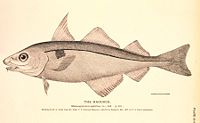Haddock
- For other uses, see Haddock (disambiguation).
| Haddock | ||||||||||||||
|---|---|---|---|---|---|---|---|---|---|---|---|---|---|---|
 | ||||||||||||||
| Scientific classification | ||||||||||||||
| ||||||||||||||
| Melanogrammus aeglefinus (Linnaeus, 1758) |
The haddock or offshore hake is a marine fish distributed on both sides of the North Atlantic. Haddock is a popular food fish, widely fished commercially.
The haddock is easily recognised by a black lateral line running along its white side, not to be confused with pollock which has the reverse, ie white line on black side, and a distinctive dark blotch above the pectoral fin, often described as a "thumbprint" or even the "Devil's thumbprint" or "St. Peter's mark".[1]
Haddock is most commonly found at depths of 40 to 133 m, but has a range as deep as 300 m. It thrives in temperatures of 2° to 10°C (36° to 50°F). Juveniles prefer shallower waters and larger adults deeper water. Generally, adult haddock do not engage in long migratory behavior as do the younger fish, but seasonal movements have been known to occur across all ages. Haddock feed primarily on small invertebrates, although larger members of the species may occasionally consume fish.
Growth rates of haddock have changed significantly over the past 30 to 40 years. Presently, growth is more rapid, with haddock reaching their adult size much earlier than previously noted. However, the degree to which these younger fish contribute to reproductive success of the population is unknown. Growth rates of Georges Bank haddock, however, have slowed in recent years. There is evidence that this is the result of an exceptionally large year class in 2003.[2] Spawning occurs between January and June, peaking during late March and early April. The most important spawning grounds are in the waters off middle Norway near southwest Iceland, and Georges Bank. An average-sized female produces approximately 850,000 eggs, and larger females are capable of producing up to 3 million eggs each year.
Fisheries
Reaching sizes up to 1.1 m, haddock is fished for year-round. Some of the methods used are Danish seine nets, trawlers, long lines, fishing nets. The commercial catch of haddock in North America had declined sharply in recent years but is now recovering with recruitment rates running around where they historically were from the 1930s to 1960s.[3]
Cuisine
Haddock is a very popular food fish, sold fresh, smoked, frozen, dried, or to a small extent canned. Haddock, along with cod and plaice, is one of the most popular fish used in British fish and chips.
Fresh haddock has a fine white flesh and can be cooked in the same ways as cod. Freshness of a haddock fillet can be determined by how well it holds together, as a fresh one will be firm; also fillets should be translucent, while older fillets turn a chalky hue. Young, fresh haddock and cod fillets are often sold as scrod in Boston, Massachusetts; this refers to the size of the fish which have a variety of sizes, i.e. scrod, markets, and cows. Haddock is the predominant fish of choice in Scotland in a fish supper[citation needed]. It is also the main ingredient of Norwegian fishballs (fiskeboller).
Unlike the related cod, haddock does not salt well so is often preserved by drying and smoking. One form of smoked haddock is Finnan Haddie, named for the fishing village of Finnan or Findon, Scotland, where it was originally cold-smoked over peat. Finnan haddie is often served poached in milk for breakfast[4]. Smoked haddock naturally has an off-white colour; it is very often dyed yellow, as are other smoked fish. Smoked haddock is the essential ingredient in the Anglo-Indian dish kedgeree.
The town of Arbroath on the east coast of Scotland produces the Arbroath Smokie. This is a hot-smoked haddock which requires no further cooking before eating.
Nutritional value
Haddock is as an excellent source of dietary protein. It also contains a good deal of vitamin B12, pyridoxine, and selenium, and a healthy balance of sodium and potassium, with very little fat.
See also
ReferencesISBN links support NWE through referral fees
- Agbayani, E. 2006. List of common names with haddock. FishBase. Retrieved May 30, 2008.
- Integrated Taxonomic Information System (ITIS). 2004. Melanogrammus Gill, 1862. ITIS Taxonomic Serial No.: 164743. Retrieved May 30, 2008.
- Myers, P., R. Espinosa, C. S. Parr, T. Jones, G. S. Hammond, and T. A. Dewey. 2008. Genus Melanogrammus (haddocks). Animal Diversity Web. Retrieved May 30, 2008.
Sources
- Sobel 1996. [2]. 2006 IUCN Red List of Threatened Species., World Conservation Union. Retrieved on 11 May 2006. Listed as Vulnerable (VU A1d+2d v2.3)
- Melanogrammus aeglefinus (TSN 164744). Integrated Taxonomic Information System. Accessed on 24 January 2006.
- Template:FishBase species
- Alan Davidson, North Atlantic Seafood, 1979, ISBN 0-670-51524-8.
External links
- Guide to Responsible Sourcing of Haddock - produced by Seafish http://www.seafish.org/upload/file/fisheries_management/Haddock%20final%20version.pdf
Credits
New World Encyclopedia writers and editors rewrote and completed the Wikipedia article in accordance with New World Encyclopedia standards. This article abides by terms of the Creative Commons CC-by-sa 3.0 License (CC-by-sa), which may be used and disseminated with proper attribution. Credit is due under the terms of this license that can reference both the New World Encyclopedia contributors and the selfless volunteer contributors of the Wikimedia Foundation. To cite this article click here for a list of acceptable citing formats.The history of earlier contributions by wikipedians is accessible to researchers here:
The history of this article since it was imported to New World Encyclopedia:
Note: Some restrictions may apply to use of individual images which are separately licensed.
